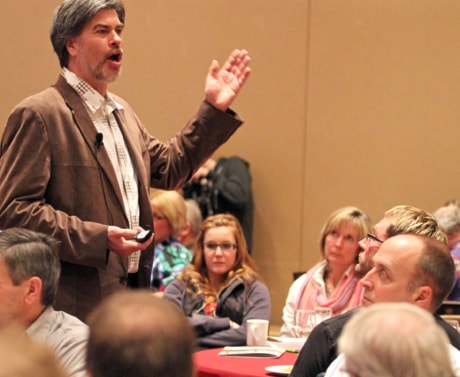The times they are a-changin’ — and fast.
This was a message that Jim Bottomley, a prominent Canadian futurist, delivered during a presentation at the AgChoices 2011 conference in Red Deer on Wednesday.
Bottomley said agricultural producers have experienced more change in the past three years than during any previous period — a statement endorsed by most of those in attendance — and the pace of change is only going to quicken.
“We ain’t seen nothing yet.”
Change, he added, brings opportunities and challenges. While some might bemoan the cost of product traceability, such programs allow for added value and premium pricing, said Bottomley.
The Jasper-based management consultant, who also owns retail and software development businesses, described one expensive wine that comes with a computer chip that documents its temperature history.
In addition to new opportunities for adding value, producers should be able to customize their products for smaller and smaller markets — right down to individuals. Bottomley offered the example of Japanese bicycle manufacturers that build to the dimensions and needs of a single customer.
He also pointed to a successful Canadian business that sells ginseng coffee to Asian health food stores, and another that produces sound-suppressing clothing for hunters.
“If you can customize anything for an end user, you get more value for it.”
Bottomley said consumer markets are increasingly about “need satisfaction.” Businesses must identify the needs of their customers and adopt strategies to serve these.
“If you want to make more money, if you want to improve your profits, start with a better benefit.
“Better benefits are really the driving force behind everything in business success.”
Family farms can no longer simply produce a commodity, said Bottomley. Instead, they need to manage a portfolio of crops and/or livestock.
Agriculture is a tough sector to operate in because it’s intertwined with politics — with government programs, subsidies and trading practices complicating the landscape, he said.
Looking ahead, the global population is projected to hit nine billion by 2045, said Bottomley.
“That’s two billion more mouths to feed.”
Demand for food will also be pushed upward by a growing middle class, he added.
Meanwhile, technological change will drive innovation and productivity, said Bottomley.
Demographics will also shape the future, he said, as baby boomers advance into and through their senior years — skewing markets and influencing governments.
AgChoices is held annually. It’s sponsored by Growing Forward, a federal-provincial-territorial initiative.
hrichards@www.reddeeradvocate.com
